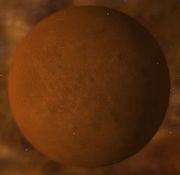User:Ursus/Data Test
This article has not been verified to be up to date for the latest version of the Discovery mod. The last edit was made on 16.12.2012 (DD/MM/YYYY). You may help by updating it, often by using the code generator.
| Omega-11 | |
| System | |
| Governing House | Independent |
| Region | Border Worlds |
| Connected Systems |
Dresden Omega-41 Omega-5 Omega-54 Omega-55 Omega-7 Stuttgart |
The Omega-11 system is a unique and dangerous system. At its core lies a dying red giant star, a huge ogre, belching out fire and radiation across the system. Most of its planetary bodies have been broken up by the intense tidal and thermal forces of the star as it reaches its death throes. Heat and radiation bathe this forsaken system in an eerie red light that begins eroding the hulls of any ship that enters. The numerous planetary debris clouds provide minor cover from its lethal effects, but any movement outside these fields and a ship will enter the perilous Abgrund, a region of space so alive with deadly particles that to even enter it can be fatal.
There is but one reason why humans come to this system: the break up of the planets, and the continued dissolution of the Omega-11 star releases vast amounts of mineral wealth into space in the form of diamonds. The abundance of these beautiful and normally rare objects is enough to lure many into the system seeking wealth. The area most rich in diamonds is the molten Von Rohe Belt that lies around the outer extent of the corona of the dying star. To get there one must brave the Abgrund and the hightened heat and radiation from being so close to the huge star, not to mention the proximity of the corona means a single mistake in course can cause a ship to plummet into the dying giant's deathly embrace. Yet people still travel to the belt to mine the diamonds and to search for wrecks: the hulks of ships who braved the Abgrund and fell foul of it now float around the belt as a testament to their former owners' foolishness. Yet within these hulks there is yet again the promise of bounty as many of these ships still contain salvageable objects for those who can find them and survive the journey.
System Overview
|
Astronomical Bodies
Stellar Objects
|
Industrial Development
|
Faction Presence
Lawful Factions
Corporations & Guilds
Unlawful Factions
|
Planetary Bodies
Planet SchutzLocation: C/3
|
|
Planet DeidusLocation: D/6
|
Nebula and Asteroids
Von Rohe BeltLocation: D/5
|
File:Von Rohe Belt.jpg Von Rohe Belt |
Kraft FragmentLocation: F/3
|
File:Kraft Fragment.jpg Kraft Fragment |
Franke FragmentLocation: D/3
|
File:Franke Fragment.jpg Franke Fragment |
Jeschke FragmentLocation: C/4
|
File:Jeschke Fragment.jpg Jeschke Fragment |
Madsack FragmentLocation: C/5
|
File:Madsack Fragment.jpg Madsack Fragment |
Mineable Commodities
Uncut Diamonds
Location: D/6, D/6, E/6, F/5, F/4, D/5
- Ore is a type of rock that contains minerals such as gemstones which can be extracted through mining and refined for use. The ores must be processed to extract the gemstones of interest from the waste rock and from the ore minerals. Many organizations prefer to receive unprocessed ores in order to keep the additional cost of their production and finish within the local economy, as opposed to paying markups to foreign laborers to do the work for them.


